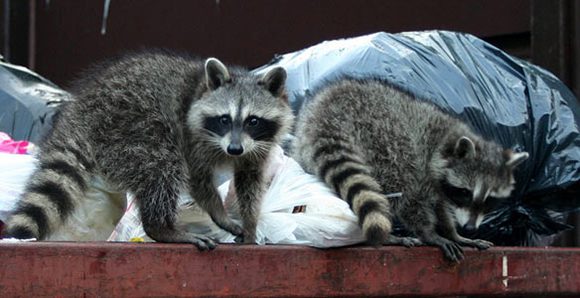Spring is here bringing with it rolling thunderstorms, warming temperatures and an urban forest full of newborn raccoon pups.
Toronto’s burgeoning raccoon population has recently gone viral, thanks to a youtube video (at right) showing a raccoon threading its way across a Danforth area neighbourhood’s powerlines.
Last year, raccoons were in the news when Toronto homeowner Dong Ngyuen was fined $1,365 and 200 hours of community service after being found guilty of animal cruelty. Ngyuen was charged after he attacked a family of raccoons that had been tearing up his garden.
In the ensuing debate some Torontonians have been wondering exactly how do we address urban raccoon problem humanely.
Troy Leneeuw [http://www.gtapestcontrol.ca] from GTA Pest Control deals with raccoon removals almost daily. He thinks it isn’t so much about killing raccoons or removing them as it is making life difficult for them in the city.
“Part of the problem is a lot of our buildings are built in a way that makes it easy for them to get into,” he said.
“Most houses have paper-thin roof vents that they can easily claw their way in through, you just have to make sure your house is protected. Most of the roof vents and dryer vents are plastic or aluminum and aren’t protected at all.”
But that’s not the end of the problem. According to Troy the law says that even when a raccoon is trapped and removed from a residence it can only be moved a kilometre before release.
Even if raccoons were dubbed ‘pests, which would allow for them to be killed like mice and rats, Troy says it wouldn’t make a dent in controlling the population, killing off one raccoon leaves a gap which another raccoon would eagerly fill.
Troy did offer however that if you make the environment too much of a hassle for the raccoons it forces them to move along.
Toronto City Councillor Glenn De Baeremaeker (Ward 38 Scarborough Centre) has dealt with raccoon problems himself recently.“You’ve got to outsmart the animal,” he said.
“They use the downspout like a jungle gym and your fences like a super-highway. If they starting digging in your garden try some mesh or light fencing, make it difficult for them to live with us and they’ll stick to the ravines.”
“Two of them got up into my roof and were really loud,” De Baeremaeker said.
“I called the pest control guy and yeah it ousted me $200 but it solved the problem. I actually thank them because it showed me a problem I had with my house.”
The city of Toronto has also been investigating ways to improve green recycling bins, with current versions offering little challenge to street-savvy raccoons.
“We’ve been looking into animal proofing green bins,” De Baeremaeker said.
“They smell the food in there and they knock them over and get into them, so we’re looking at latches and animal proofing so they could knock it over but it wouldn’t spill or they couldn’t claw their way in through the plastic.”
Toronto has the second most dense urban wild-life population following Paris, France, and though it looks like raccoons are here to stay De Baeremaeker says it’s about finding the right balance for co-existence .
“You don’t need to attack them,” he said “We need to establish a sense that raccoons live in the valley or ravine and we live with our houses.
“Honestly I try to scare them off. I see a raccoon on my back patio so I head to the side door and open it, usually they run off by then, if not I usually try to scare them by yelling or get the garden hose.”

